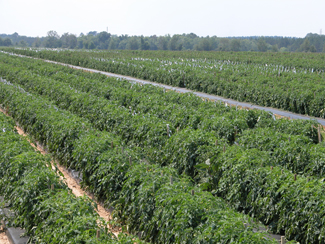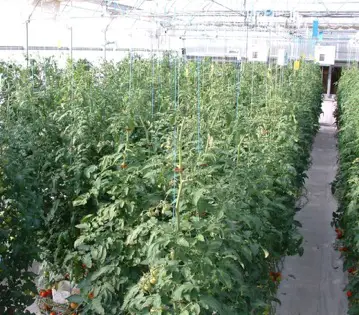A tomato plant can produce around 10 to 15 pounds of tomatoes per season. Tomatoes are a popular crop for home gardeners and farmers due to their versatility and delicious taste.
However, it’s important to understand how many tomatoes to expect from each plant per season. On average, one tomato plant can yield around 10 to 15 pounds of tomatoes, although this can vary depending on the variety of tomato, growing conditions, and care.
Factors that can affect tomato yield include watering, fertilization, pruning, and pest control. With proper care and attention, a tomato plant can produce a bountiful harvest for you to enjoy throughout the growing season.

Credit: extension.uga.edu
Factors Affecting Tomato Yields
Tomatoes are a favourite among gardeners due to their versatility and nutritional value. However, the yield of tomatoes per plant can vary due to a range of factors. Here are some crucial factors that influence tomato yields.
Climate And Weather Conditions
- Tomatoes are warm-season plants and require a warm climate to grow. They require a minimum of six hours of sunlight per day to thrive.
- If temperatures rise above 90°f, pollination may be affected, which can lead to a smaller amount of fruit and lower yields.
- Cool temperatures can also cause issues, especially during the flowering stage, which results in poor pollination and limited fruit production.
Choice Of Tomato Variety And Seed Quality
- Tomato plants have many variations, and choosing the right one for the climate can affect the yield.
- Using quality tomato seeds is essential, as it dictates how robust the plant will be. Varieties with strong resistance to pests and diseases are more likely to yield a larger amount of fruit.
Soil Quality And Preparation
- Tomatoes need nutrient-rich soil that is well-draining. Soil with high organic matter content can retain moisture and provide the necessary nutrients.
- The soil’s ph should be between 6.0 and 7.0, as soil that is too acidic or alkaline can hinder the growth of tomato plants.
- Proper soil preparation, such as tilling and amending with organic matter, can go a long way in maintaining soil health and increasing tomato yields.
Fertilizer And Nutrient Management
- Regular fertilization is crucial for tomato production. Tomatoes require a balance of nutrients such as nitrogen, phosphorus, and potassium.
- Adding organic matter, such as compost, can help maintain soil fertility and improve nutrient uptake.
- Overfertilization can lead to excessive vegetative growth at the expense of fruit production, so it is essential to apply fertilizer according to the plant’s stage of growth.
Pest And Disease Control
- Tomato plants are susceptible to various pests and diseases that can affect the yield. Pests like aphids, whiteflies, and hornworms can cause significant damage to plants.
- Diseases such as blight, wilt, and powdery mildew can also result in reduced yields. Proper pest and disease control practices, such as using natural predators and disease-resistant crops, can help increase tomato yields.
Several factors influence tomato yields. By taking the necessary steps to manage these factors, gardeners can grow healthy tomato plants and produce a bountiful yield.
Understanding Plant Growth And Maintenance
How Many Tomatoes Per Plant Per Season
Are you wondering how many tomatoes per plant per season you can expect? Whether you are a seasoned gardener or a novice, understanding plant growth and maintenance is crucial to achieving a bountiful harvest. We will explore the key factors that will influence the yield of your tomato plants.
Read on to learn more!
Definition Of Determinate And Indeterminate Tomato Plants
Before we dive into plant growth and maintenance, it’s essential to understand the difference between determinate and indeterminate tomato plants. Determinate varieties grow to a specific height and produce a finite number of fruit. Indeterminate tomato plants, on the other hand, will grow and produce fruit continually until the weather turns too cold for them to thrive.
Staking And Pruning Techniques For Optimal Plant Growth
Proper staking and pruning techniques are essential for ensuring optimal plant growth and maximum yield. Here are some key points to consider:
- Stake your tomato plants early in the season to support their weight, and keep them from falling over.
- Prune your plants regularly to remove unwanted growth and promote air circulation.
- Use pruning shears to remove any leaves or branches that appear to be diseased or damaged.
Watering And Irrigation Requirements
Tomato plants require a consistent supply of water throughout their growing season. Here are some tips on how to ensure that your plants receive the water they need:
- Water your tomato plants deeply and thoroughly once a week, ensuring that the soil is moist but not waterlogged.
- Use a watering can or soaker hose to deliver the water directly to the plants’ roots, rather than overhead.
- Consider using a drip irrigation system to provide a consistent supply of water to your plants, especially during hot, dry weather.
Harvesting Practices
Finally, harvesting your tomatoes correctly is essential to ensure that you get the most out of your crop. Here are some tips to keep in mind:
- Harvest your tomatoes when they are fully ripe but still firm to the touch.
- Use a sharp knife or scissors to cut the fruit off the vine, leaving the stem intact.
- Never refrigerate your tomatoes, as this can cause the flavor and texture to deteriorate.
By understanding the factors that influence plant growth and maintenance, you can expect a bountiful harvest from your tomato plants. Follow the tips provided to maximize your yield and enjoy the fruits of your labor!
Measuring Tomato Yields
Growing tomatoes in your garden or farm can be both fulfilling and practical. After all, what could be better than the taste of fresh tomatoes harvested from your own backyard? However, before you begin planting, it is essential to understand how to measure tomato yields.
Explanation Of Yield Measurement Techniques
Measuring tomato yields involves keeping track of how many tomatoes have grown from every plant and the total amount for the season. There are various techniques to measure tomato yields, such as counting the number of ripe tomatoes or weighing them.
Here are a few yield measurement techniques for tomato plants:
- Counting the number of ripe tomatoes
- Weighing harvested tomatoes
- Using a tomato yield calculator
- Measuring the number of tomatoes in five-gallon buckets.
- Keeping track of the harvest time of each tomato plant.
Calculation Of Yield Per Plant And Per Season
Calculating the yield per plant and per season helps determine plant health and helps predict future yields.
To determine the yield per plant, follow these three simple steps:
- Count the number of ripe tomatoes harvested from a single plant.
- Divide the total number by the number of days it took for the tomatoes to ripen.
- Then, divide the answer by the number of healthy plants to determine the average yield per plant.
To calculate the yield per season, add up the yield per plant for each of your tomato plants and divide the result by the total number of plants.
Factors Affecting Yield Estimates
Many factors can affect yield estimates, including environmental conditions, pests, diseases, pollination, and plant variety. Understanding these factors is essential because they help you plan and prepare for any different circumstances that may affect your tomato yield.
The following factors can affect your yield estimates:
- Climate
- Water
- Soil health
- Plant spacing
- Diseases and pests
- Fertilizers
- Pollination
- Harvest time
By considering all the factors listed above, you can estimate the number of tomatoes your plants will yield. This information can help you understand your garden’s productivity, track your progress, and improve your tomato growing skills.
Measuring tomato yields can help you plan and predict the number of tomatoes your plants will produce. Accurately measuring yields provides valuable information to help improve your gardening techniques and ensure successful future harvests.
Strategies For Increasing Tomato Yields
Tomatoes are an essential component of most gardeners’ and farmers’ crops. They are rich in vitamins and provide essential nutrients, making them a versatile crop that can be used for various purposes. However, one of the biggest headaches for most growers is maximizing yields from each plant.
In this section, we discuss proven strategies that farmers and gardeners can adopt to get the most out of their tomato plants.
Proper Plant Spacing
The distance between one tomato plant and another can significantly affect yield. If the plants are too close together, they will compete for light, water, and nutrients, resulting in stunted growth, reduced yields, and a higher risk of diseases. Consider the following guidelines when spacing your tomato plants:
- For determinate varieties, a spacing of two to three feet between plants in the row is ideal.
- Indeterminate varieties need three to four feet of space between plants in a row.
- The spacing between rows should be between four to six feet, depending on the variety.
Mulching Techniques
Mulch is an essential component for any gardener or farmer who wants to maximize tomato yields. Mulch helps retain water in the soil, reduces weed growth and prevents soil-borne diseases.
- Black plastic mulch is useful when planting early in the spring. It warms the soil and accelerates crop growth.
- Organic mulches are useful in the summer months, as they help keep the soil cool and moist. Use materials such as straw, leaves, and grass clippings.
Use Of Growth Stimulants And Supplements
Tomatoes require proper nutrition to achieve maximum growth and yield. In case your soil is lacking in nutrients, consider adding organic growth supplements to boost yields.
- Nitrogen, phosphorus and potassium are essential growth nutrients. Consider adding fertilizers with these nutrients to soil.
- Add epsom salt to the soil to provide essential magnesium needed for plant growth and flower fertilization.
Season Extension Methods
Extending the tomato growing season can increase your harvest and maximize yields. Some season-extension techniques to consider include:
- Floating row covers – keep tomato plants warm in early spring or late autumn.
- Greenhouse production – allows you to control temperature, humidity and light conditions, allowing plants to grow, produce earlier fruits and yields from ripe tomatoes.
Best Practices For Crop Rotation
Crop rotation involves planting a new crop in a different area from where you planted your last crop. This practice helps to break pest and disease cycles and improves soil health.
- Tomatoes should not be planted in the same location for at least three years.
- Examples of crops to plant between tomato growing sessions include beans, corn, or small grains.
You can maximize your tomato yields by spacing your tomato plants properly, using the right mulching techniques, leaning towards organic growth supplements, extending the growing season, and adopting crop rotation best practices. By following these strategies, you can ensure that each tomato plant provides you with a bountiful yield.
Frequently Asked Questions Of How Many Tomatoes Per Plant Per Season
How Many Tomatoes Can One Plant Produce?
A single tomato plant can produce anywhere from 10 to 30 pounds of tomatoes, depending on the variety and growing conditions.
When To Expect Tomatoes From A Plant?
Tomatoes typically start to appear on a plant 55 to 85 days after planting, depending on the variety and growing conditions.
How Often Should A Tomato Plant Be Watered?
Tomato plants should be watered deeply once or twice a week, depending on the weather. Avoid watering them too frequently, as it can lead to root rot.
What Are The Best Conditions For Growing Tomatoes?
Tomatoes grow best in full sunlight and in well-draining soil that is rich in organic matter. They also require regular feeding and pruning to ensure healthy growth.
How Do You Know When A Tomato Is Ripe?
A ripe tomato should be firm but yield to gentle pressure when squeezed. The fruit should also have a deep, even color and a sweet aroma.
Conclusion
The amount of tomatoes per plant per season is a question that many gardeners have. After thorough research, it is clear that the number of tomatoes per plant per season depends on various factors such as the tomato variety, weather, soil quality, and plant care.
Indeterminate tomato varieties yield more fruit, whereas determinate varieties tend to produce less. To maximize tomato production, it is essential to provide adequate water, sunlight, and nutrients. Regular pruning, staking, and removing suckers are recommended. You can also use pesticide-free insecticides and fungicides to protect your plants from pests and diseases.
By understanding these factors and implementing the right practices, you can expect your tomato plants to yield a bountiful harvest. Happy gardening!




